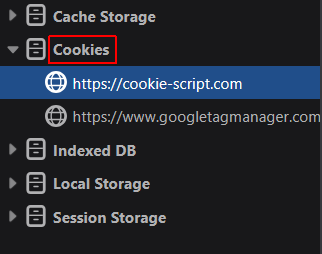ON THIS PAGE
Are you curious about what cookies are running on your website (or another website) or how to get cookies from browser? CookieScript’s Cookie Scanner s a popular cookie inspector tool. But, you can also perform a manual check using your favorite web browser.
Inspect Cookies in Google Chrome
Checking cookies on your Google Chrome web browser is fairly straightforward. Read this guide on how to get cookies from the Chrome browser.
To view cookies in Chrome, perform the following steps:
- Open Chrome settings. Right-click on your browser window, if you are running Windows; or make a two-finger click with the Magic Trackpad or press the control+click if you are running Apple Mac.
- Choose Inspect to enter the Chrome Developer Tools:

- Choose the Applications tab. Depending on the size of your screen, you may need to expand your tab options at the top by clicking on the >> symbol:

- Under the Storage tab, select Cookies:

- Select the website. Click the triangle icon, found on the left side of Cookies. You will see all the available websites. Select the website you want to see cookies in Chrome:

- View cookies in Chrome. Here you can check cookies in Chrome:

Here you can also edit or delete cookies.
All the fields are editable except Size that updates automatically. Double-click a field to edit it.
To delete a cookie, select it and click Delete selected (X) in the top action bar.
You can delete all cookies here. Click Delete all in the top action bar:
You have learned how to view cookies in Chrome using developer tools.
You can also read the following articles:
- Google Chrome for developers. Here you can find an information on how to view cookies in Chrome, add, edit, or delete them.
- What are third-party cookies?
- How to view, enable, disable, or delete cookies in Chrome?
Inspect Cookies in Mozilla Firefox
It is also quite easy to get cookies from the Mozilla browser. Read this guide on how to see cookies in Mozilla Firefox.
To view cookies on your Mozilla’s Firefox web browser, perform the following steps:
- Right-click anywhere on the Firefox browser window if you are running Windows. On Mac OS, you can either hold down control and then click with the mouse or use the two-finger click with your Magic Trackpad.
- Choose Inspect (Q) from this list:

- Choose the Storage tab. Depending on the size of your screen, you may need to expand your tab options at the top by clicking on the >> symbol:

- Under the Storage tab, select Cookies:

- Select the website. When you expand Cookies, a sub-menu will appear, allowing you to choose a particular domain.
- See cookies in Firefox. Here you can check cookies in Firefox:

Here you can also edit cookies on Firefox. All the fields are editable except Size that updates automatically. Double-click a field to edit it.
You have learned how to view cookies in Firefox using developer tools, so you can easily check cookies in the Firefox browser.
You can also read the following articles:
- What are third-party cookies?
- How to view, enable, disable, or delete cookies in Chrome?
- HttpOnly cookies.
- SameSite cookies.
Scan your website for free with CookieScript Cookie Scanner and see what cookies, including Third-Party Cookies, your website uses:
How to read the list of cookies?
There are several attributes available for each cookie:

Here you can find the information about cookie attributes:
- Name. The cookie's name.
- Value. The cookie's value.
- Domain. If the domain name corresponds with the website you are browsing, it means that these cookies are First-party cookies. If the domain name is different- these cookies are third-party cookies.
- Path. In the ‘Path’ field you can examine where a particular cookie is located; the path may show as a ‘/‘ symbol, which indicates the cookie is stored on the main index.
- Expires / Max-Age. The cookie's expiration date or maximum age. You can see whether the cookies deployed are session cookies or persistent cookies.
- Size. The cookie's size, in bytes.
- HttpOnly. If true, this means that it is a HTTP cookie. JavaScript modification is not allowed.
- Secure. If true, this means that the cookie is sent to the server only over a secure, HTTPS connection.
- SameSite. The SameSite cookie attribute is used by browsers to allow or block cookies based on attribute. It could contain Strict or Lax SameSite attributes.
- Partition Key. A cookie's partition key is the scheme and registrable domain of the top-level URL the browser was visiting at the start of the request to the endpoint that set the cookie.
- Priority. It is used with deprecated cookie priority attribute. Could contain Low, Medium (default), or High priority.
Looking for an Easier Solution?
CookieScript has you covered! Register for an account today and see how affordable it can be to ensure your website is compliant with global privacy laws and regulations.






